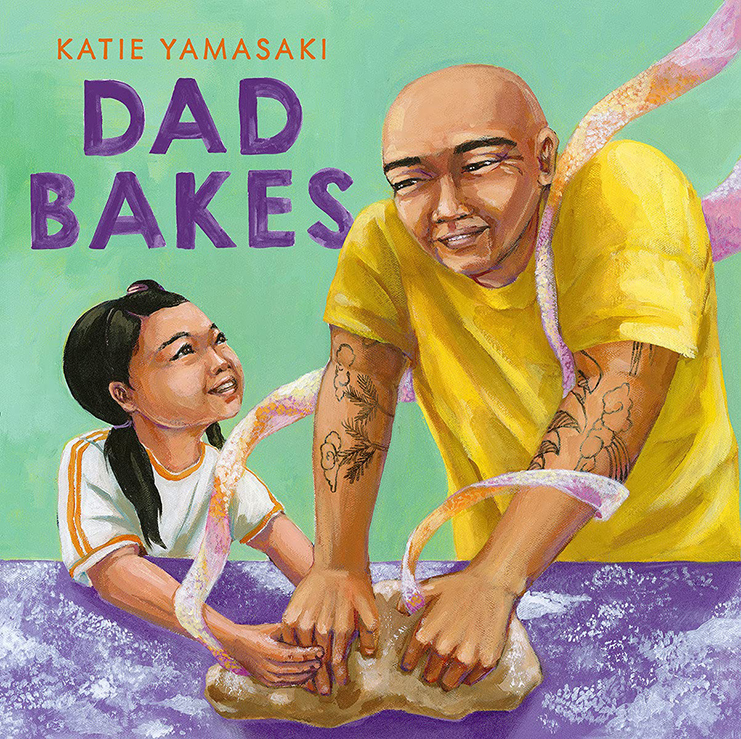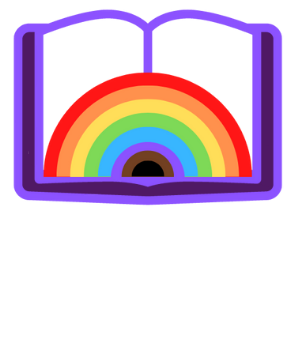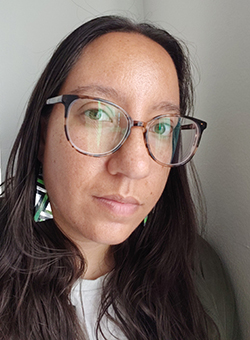A Note from Stefanie (Library for the Kind)
When I first read Katie Yamasaki’s book “Dad Bakes,” I read it without knowing where the child’s father had been. It is clear she is waiting for him to get home. Was he away in the military, on a long vacation or maybe he is divorced from her mother?
Where was Dad?
It was none of those reasons. Upon reading the author’s note at the end of the book, the whole story came together. This caring, delicate, wonderful father was incarcerated.
We do not have nearly enough books that tackle incarceration. Katie’s loving words and art challenge the negative stigmas surrounding incarceration. They remind us that sometimes bad things happen to good people. And we’re all more complex than one thing about ourselves.
Murals
I can’t talk about Katie Yamasaki without bringing up her mural work. Early in her career, Katie spent time working with teens. She mentored and together they created masterpiece murals on large city buildings. Brightening homeless shelters and senior centers. Seeing “art as a way to communicate.” Katie’s murals focus on themes such as social displacement and social justice.
“Katie’s mural projects advocate to end the criminalization of victims of stillbirth and domestic violence as well as the mass incarceration of women in poverty. She looks forward to exploring its impact on families in an upcoming project with the Women and Justice Project.”
“Woman Rise” at the BRC Homeless Shelter in Brooklyn, NY https://makemeaning.org/artist-katie-yamasaki-paints-murals-as-platform-for-change/
Currently, Katie Yamasaki’s work can be seen all over the world!
I received such wonderful comments about your book “Dad Bakes.” So many children need books on this topic and there are so few that are published. What was your inspiration to create this book?
Thank you so much. For the past 12 years or so, I’ve done a lot of work with communities who are impacted by incarceration. I’ve worked with incarcerated mothers in various correctional facilities, different groups of incarcerated teens, children who have a parent who is incarcerated and many families who are going through the re-entry process.
Stories Untold and Misrepresented
It has been a privilege to partner with these communities and get to know people whose stories are so often untold and misrepresented. I am really lucky to have these platforms- books and murals, to dive more deeply into these stories and develop fully human characters that better represent the people I have come to know through my life and work.
So often, when people become incarcerated, the labels of felon, inmate or criminal – or in the language of children, bad guy- become the single, defining identity of a full human being.
We Are All So Much More
Because we are all much more than any one thing- even the worst thing we’ve done or experienced, I wanted to create a story that explored the full humanity of these characters and allowed the reader to get to know the dad character first as a father, a baker, a cat lover, a gardener, etc., before learning of his former incarceration experience.
Everyone Deserves Representation with No Judgement
We all deserve, but are not always granted the right to full, human representation, and I was excited to develop this father character in Dad Bakes to give the reader an opportunity to see people in this circumstance a little more clearly.

“If Walls Could Talk”
This mural in East Harlem, was painted on a wall by children waiting for thier moms to be released from prison.
I tend to read books before reading what they are about. When I read “Dad Bakes,” I loved the subtle hints you give on the first pages where you see the little girl drawing a picture and a calendar with a countdown in the background. Did you intend for readers to not connect or make assumptions about where her Dad has been?
Like I mentioned in the previous question, it was really important for me to let the reader get to know both Dad and the daughter before learning their backstory — ideally, how we get to know people in real life — without judgment and preconceived notions of what it means to have been incarcerated. Certainly, the father’s incarceration would have an impact on his life and on the life of his daughter.
A Loving Father
But, more important to the story is that he is a loving father. That he is present, engaged and living a full life. I think that learning that he had been incarcerated in the author’s note, at the end of the book, provides a more tender understanding of two characters who the reader has already learned to identify with. Maybe the reader knows what it is like to wait for someone. What it is like to hold a loaf of bread, warm from the oven in their hands. What it is like to chase a soccer ball with someone they love. So, already, there will be more points of connection and more empathy when they find out the history of the father and daughter. If, like over 5 million children on any given day in the US, the reader has a parent in a correctional facility, they will hopefully see their story and their parent represented on multiple levels beyond their experience with separation and incarceration.
Bad vs. Good is Too Simplistic
There is often an overly simplistic binary around going to jail or prison- if you’re bad, you go away. If you’re good, you stay. It kind of “others” people and is very unhelpful when encouraging young readers to explore the complexity of the world in which we live, and see each other more clearly. I think that leaving the backstory to the end of the book provides all readers the chance to better have that open hearted experience with the characters and their story.

“Justice”
Painted on the back wall of On the Rise Bakery, a program of the Capuchin Soup Kitchen to help train people who have recently been released from prison, the mural of Martin is often enveloped in the warm, wafting smells of freshly baked bread. Quoted from hourdetroit.com
Patience and waiting are such strong themes in this book. Can you tell us more about these themes and any others you incorporated?
Waiting is hard for all of us. It can be especially hard for children and when we understand the backstory of these characters, the daughter in particular, we can learn from her. Her ability to wait- for her father to come home from prison (alluded to in the early spreads of the book), to wait for him to come home from work, to wait for him to wake up, to wait for the bread to finish
baking . . . All of her waiting alone, and then waiting together, it was full of her living in the present moment.
Living In the Moment
While she, and then they, were waiting, they were drawing, reading, cooking, planting, pet grooming, playing, watching . . . Living these moments of waiting with all of their senses awakened. That kind of fully engaged living is a way to stay in the present moment and not spent too much time longing for the future or agonizing over the past. It obviously has to do with the waiting that happens for families and individuals impacted by incarceration, but there is really something there for everyone. We all know how it feels to be waiting for a really long time, and how can we let that time be a space of growth, connection and healing?
Your book includes images of people of all different races and genders. It makes the book feel real and relatable to me. Can you tell us about the people and the setting of “Dad Bakes”?
The people in “Dad Bakes” are just like the people I see in my everyday life. Growing up, I always found it strange and troubling that there were no books with people who looked like me and the people in my family.
Made Invisible
I have devoted my whole career as an artist to creating work that better reflects the people I see in my everyday life who are so often underrepresented, misrepresented, and made invisible by mainstream media and society.
We Need Diverse Children’s Books
https://www.nea.org/advocating-for-change/new-from-nea/why-we-need-diverse-books
Books like “Dad Bakes” are sometimes put in the parenting area in libraries. Do you have plans on writing more “hard topic” books?
I am currently working on a book that shares some themes with “Dad Bakes,” and also just finishing work on my grandfather’s biography. It does seem that with my books- Japanese internment, gentrification, mass incarceration, etc., I am often doing the “hard topic” books.
Reflecting The Challenges of Everyday Life
That said, I think that these are really just everyday life, mirror books for so many young readers. I was a teacher for 14 years, and it was hard to find books that showed and spoke frankly and openheartedly about the daily challenges of everyday life, with fully realized characters, that my students were hungry for. I hope that no matter where my books end up, that children will relate and connect and that grownup readers will find avenues into hard conversations with their children and students that maybe they didn’t previously know how to access. I’m so grateful to all of the educators and parents who take this tender time to explore my books with their young readers.
“In 2013, Yamasaki wrote and illustrated the children’s picture book Fish for Jimmy, inspired by a family story about an uncle who was held as a boy during World War II at Granada War Relocation Center in Colorado.” – hourdetroit.com
I noticed that on the page with Dad and the other workers at the bakery, one of the men has a tattoo that says 118. Is there symbolism in this or symbolism on any other people in the book?
It’s fun to hide little things in the illustrations. That number, 118, means different things to three of my best friends. One birthday on 1/18, another birthday on 11/8 and a home on 118th Street. One number, 3, of my best friends get a little shoutout in the book. Also, if you are looking closely, you will see that the tattoos on the dad’s arms evolve through the story from very stormy, windy and torrential in the beginning, to more placid and calm at the end. Most people don’t see that, but it’s a kind of second narrative to represent the dad’s journey.

Your art style is stunning. What mediums do you use in your artwork?
Thank you so much. “Dad Bakes” is just acrylic paint on canvas. Sometimes I do collage and use gouache paint, but I mostly paint my books in acrylic the same way I paint my murals. In “Dad Bakes,” I especially wanted to use really vibrant colors.
The Sensory Experience of Incarceration
In correctional facilities, there can be an extreme lack of positive sensory experiences. The sounds, smells, visuals, etc., can all be kind of like an assault on the human sensory experience. The colors of prison are as you would imagine.
The Dad is Vibrant
And I wanted to show the dad as much more than that- show the world he built around him and his daughter as full of color, the warm smells of homemade food, the feeling fresh air on your face, and the sounds of loving engagement. So, this color palette for this book is extra vibrant, just like Dad, his daughter and the world they have built together.


I want to thank Katie Yamasaki for her time in answering our questions. She is an absolute force of nature! Her words and art are an inspiration to all and are valuable to children who need them.
You can learn even more about Katie on her website! You can also follow her on Instagram, and Twitter so you don’t miss any of her exciting upcoming releases!
-Stefanie









